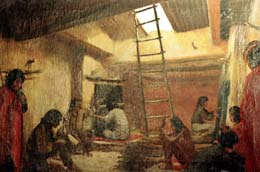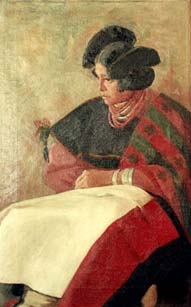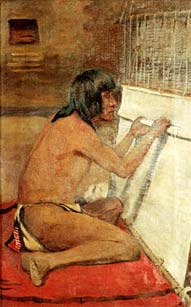The Waukegan Historical Society is proud to have in its collection three original paintings by former Waukegan resident Kate Cory.
 Inside the Kiva (c.1905-1912) Oil on Canvas. 20 in. x 30.25 in. Waukegan Historical Society
Inside the Kiva (c.1905-1912) Oil on Canvas. 20 in. x 30.25 in. Waukegan Historical Society
Kate Cory was born on February 8, 1861, and resided at 321 North Utica Street (now 321 N. Martin Luther King, Jr. Ave) until 1880 when her father relocated the family to Newark, New Jersey, in order to tend to his business interests on Wall Street. Not much is known of her early childhood in Waukegan. Although Kate was only 19 years old when she left Waukegan, she corresponded with residents of Waukegan throughout her life. She made a final visit to the city in 1939.
The Cory Family in Waukegan
Kate’s uncle, Dr. David Cory, was a local doctor and abolitionist who had close ties to Abraham Lincoln and Ulysses S. Grant. Dr. Cory was also a well respected religious thinker and was published in the spiritualist journal the North-Western Orient.
 The Cory House. July 2006.Kate Cory’s father, James, was a prominent newspaper editor and an outspoken abolitionist. At the onset of the Civil War, James Cory wished to enlist alongside his employees but they felt that he would be of greater service writing about life at home and further inspiring the Union effort. Through nearly every phase of the war, Cory kept the Waukegan Gazette running, oftentimes acting as its sole writer, editor, printer and distributor.
The Cory House. July 2006.Kate Cory’s father, James, was a prominent newspaper editor and an outspoken abolitionist. At the onset of the Civil War, James Cory wished to enlist alongside his employees but they felt that he would be of greater service writing about life at home and further inspiring the Union effort. Through nearly every phase of the war, Cory kept the Waukegan Gazette running, oftentimes acting as its sole writer, editor, printer and distributor.
Kate’s father, who also entertained Abraham Lincoln in their home, employed a bold method in hiding his abolitionist activities - he didn’t. Cory felt that by making his household activities highly visible he could more easily conduct passage along the Underground Railroad. Cory’s free black servants were allowed to run errands throughout Waukegan unsupervised. Cory exploited the assumption that any African Americans in the company of his servants were also working for him. James Cory’s servants were able to escort runaway slaves to boats waiting in Waukegan’s harbor under the guise that they were conducting business for Mr. Cory there. In 1997, James Cory’s involvement with the Railroad was more closely confirmed by College of Lake County Professor, James Dorsey, and homeowner Charles Olivier when a double wall and hidden room were found in the cellar of the house on Utica Street.
Cory’s Education and Life in New York
Cory graduated from Waukegan’s Central School. When her family relocated to the East Coast, Cory attended the prestigious Cooper Union where she excelled in both oils and photography. Cory would also study at the Art Students League. In 1905, at a meeting of the Pen and Brush Club she was introduced to Louis Akin. Akin had just returned from an 18 month commission in Arizona painting the Hopi people and the Grand Canyon in order to increase tourism along Santa Fe Railroad routes. Akin was intent on starting an artist’s colony on the mesas surrounding the Hopi lands and persuaded Cory to leave for Arizona that same year. While Akin’ artist settlement was never fully realized, she remained in Arizona until her death in 1958.
The Hopi
The Hopi have inhabited the area that is now the northeast corner of Arizona since about 500 CE. According to the Hopi Tribe’s website (hopi.nsn.us), archeologists have determined that agriculture was introduced to this area around 1500 BCE from Central America and Mexico. The Hopi have excelled at improving diease, pest, and drought resistant crops in this increasingly arid region. Not only have the Hopi selectively bred crops to deal with such hardships, but they also developed farming techniques to deal with the climactic hardships of desert farming. Beyond a lack of water, deserts are subject to extreme swings in temperature and high winds. The Hopi first developed a system of dry farming in which crops were planted along natural water collection points such as seasonal river beds and at the base of hills. Also, as part of this method, crops were planted amongst the natural flora which acted as a windbreak and held the topsoil in place. Around 1200 CE the Hopi started using irrigation ditches fed by natural springs. The traditional Hopi village is called a pueblo, a series of stone masonry cubicles built along a cliff which acts as a natural defense against attack.
Cory’s Accomplishments
 Mana with Ceremonial Robe (1909) OIl on canvas. 22 in. x 14 in. Waukegan Historical SocietyFrom 1905 through 1912, Cory lived amongst the Hopi people of the Oraibi Mesa. It is doubtful that any one person outside the Hopi themselves has documented their mythology and folk ways more than Kate Cory. Cory took more than 500 photographs of the Hopi people and is believed to be the last person to have photographed them on their reservation (the Hopi placed a ban on photographs taken on the reservation in in 1917 because they were concerned over the exploitation of certain sacred rituals). While Louis Akin and other photographers had visually documented the Hopi before her, Cory is unique in that she captured the entire ceremonial calendar. In addition to chronicling the Hopi people on canvas and film, she also wrote down her experiences of living with the Hopi in her unpublished journal, “Of Living with the Hopis.” Due to the intensity and sincerity of her work on the Oraibi Mesa, Cory was invited to join the Hopi Nation but declined because she “did not want to cramp their style.”
Mana with Ceremonial Robe (1909) OIl on canvas. 22 in. x 14 in. Waukegan Historical SocietyFrom 1905 through 1912, Cory lived amongst the Hopi people of the Oraibi Mesa. It is doubtful that any one person outside the Hopi themselves has documented their mythology and folk ways more than Kate Cory. Cory took more than 500 photographs of the Hopi people and is believed to be the last person to have photographed them on their reservation (the Hopi placed a ban on photographs taken on the reservation in in 1917 because they were concerned over the exploitation of certain sacred rituals). While Louis Akin and other photographers had visually documented the Hopi before her, Cory is unique in that she captured the entire ceremonial calendar. In addition to chronicling the Hopi people on canvas and film, she also wrote down her experiences of living with the Hopi in her unpublished journal, “Of Living with the Hopis.” Due to the intensity and sincerity of her work on the Oraibi Mesa, Cory was invited to join the Hopi Nation but declined because she “did not want to cramp their style.”
While living with the Hopi, Cory faced many technical and cultural obstacles. One difficulty was procuring enough water to develop her photographs in the field. In her diary, she relates how she would regularly screen the cistern on top of her pueblo for dead mice before she was able to use the rainwater. Another story, related in her manuscript “Nothing Haphazard in the Hopi Hairdo,” was the difficulty in navigating certain Hopi taboos for the sake of her creative efforts.
The traditional hairstyle of an unmarried Hopi woman is known as a squash blossom and refers to the ornate flower of one of their crops. Once a Hopi woman was married she wore her hair down, signifying the end of her maidenhood and a redirected focus on managing a household. Once married, a woman was not to wear her hair in this manner, for it would be perceived that the matron was reliving her past as an unmarried woman. Kate was struck by the physical beauty of one married woman on the mesa, and eventually convinced her wear her hair and robes in the style of a young Hopi maiden for a portrait. The two conspired to meet in secrecy for a modeling session in Cory’s studio. The woman dressed in her matronly manner and changed into her regalia in the secrecy of Cory’s apartment at the top of the pueblo. As Cory was nearing completion for the painting’s underlying sketch, some curious children that had been watching told the elder women of the pueblo what was happening. The women rushed to Cory’s studio and demanded that the woman put her hair down. Kate and the woman complied, and Cory finished the painting without her model.
During this formative period, Cory did spend time away from the Hopi reservation, acting as a technical advisor on films in California.
 The Weaver (c. 1905-1912). Oil on canvas. 22 in x 14 in. Waukegan Historical SocietyIn 1913 Cory was honored with the exhibition and subsequent purchase of one of her landscapes at the famed Armory Show. The Armory Show took place at the 69th Infantry Regiment Armory in New York City and was for many Americans their first encounter with European avant garde artists such as Wassily Kandinsky and the Cubists Duchamp and Picasso. Cory’s success at this show would elevate her reputation to an international level.
The Weaver (c. 1905-1912). Oil on canvas. 22 in x 14 in. Waukegan Historical SocietyIn 1913 Cory was honored with the exhibition and subsequent purchase of one of her landscapes at the famed Armory Show. The Armory Show took place at the 69th Infantry Regiment Armory in New York City and was for many Americans their first encounter with European avant garde artists such as Wassily Kandinsky and the Cubists Duchamp and Picasso. Cory’s success at this show would elevate her reputation to an international level.
During World War I she returned to New York and is credited with starting one of the first Victory Gardens. While there she also drafted American copies of British airplane plans and worked on improving airplane camouflage.
During the 1920s and 30s, Cory teamed with noted Arizona artist Sharlot Hall to advise a group of Prescott businessmen (called the Smoki People) interested preserving the culture of local Native Americans. Not only did she advise in the accuracy of their dance and costumes, she also helped in the design and furnishing of the Smoki Museum.
Outside of these accomplishments, Cory sculpted and designed books, wall paper, and china patterns. When companies’ interest in her china patterns demanded too many deviations from her more traditional patterns, she dropped this project. Kate Cory was able to enjoy her success within her own lifetime, living off of the income generated from her commercial work. It should also be noted that from the earliest point in her career Kate had signed her work with her full name, Kate T Cory. This is significant because many of her female contemporaries signed only with their last name, in hope of generating a greater following.
Kate Cory died on June 12, 1958, at the Pioneer Home in Prescott, just blocks from her old frontier residence. Today her works are held by the Smithsonian Institution, The Smoki Museum, and the Sharlot Hall Museum in Prescott, Arizona.
In addition to the three original paintings by Kate Cory, the Waukegan Historical Society has within its archive correspondence between Kate and local residents, scholarly and periodical articles relating to her life’s work, and historical documents concerning the Cory family history.The information for this article was compiled from the Waukegan Historical Society’s archive at the Raymond Library.
Methodology
Cory completed her paintings from the photographs she took, from sketches, and painting en pleine aire. Her images of Native Americans have always been commended for a sensitivity that was lacking from the works of earlier Native American portraitists and her ability to capture the minutia of ceremonial regalia and mannerisms. In the 1980s and 1990s, several art history scholars began a serious look at Cory’s work and have invariably credited her intuitive understanding and portrayal of the Hopi culture to her feminist perspective. We may also infer that the care with which she captured the Hopi religious life was influenced by her Abolitionist and spiritualist roots in Waukegan.
Provenance of the Paintings in the Waukegan Historical Society Collection
Cory painted these images (The Weaver, The Kiva and Mana with Ceremonial Robe) as part of a commission from the Smithsonian Institution in Washington D.C. between 1905 and 1912. As a tribute to Cory, the Smithsonian’s Natural History Museum set aside one room for the display of her work and these remained in their collection for 30 years. The Lake County Art League then purchased these three paintings, bringing them back to the Waukegan area for safekeeping. Harriet Connolly, a local art teacher, would use these paintings over the years as an instructional aid, taking them from classroom to classroom. In need of restoration, the Art League gifted these works to the Waukegan Historical Society in 1971. Finally, in 1998, the Waukegan Historical Society was able to gather the sufficient funds to have the paintings cleaned, re-stretched and repaired.
—Lucas Bucholtz, (July 2006)
Additional Reading
The following complete works are availabe in the Raymond Library:
Johnson, Ginger. Kate T. Cory: Artist of Arizona, 1861-1958. Prescott, Arizona: 1996.
Nucci, Sarah Louise. Kate Thomson Cory: An Independent Victorian Woman in Arizona. Master's thesis, Arizona State University, 2001.
Excerpts in the Raymond Library:
Dawdy, Doris Ostrander. Artists of the American West; A Biographical Dictionary. Chicago: Sage Books, the Sallow Press Inc., 1974.
Samuels, Peggy and Harold. The Illustrated Biographical Encyclopedia of Artists of the American West. Garden City New York: Doubleday & Company Inc., 1976.
Trenton, Patricia, ed. . Independent Spirits: Women Painters of the American West, 1890-1945. University of California Press, 1995.